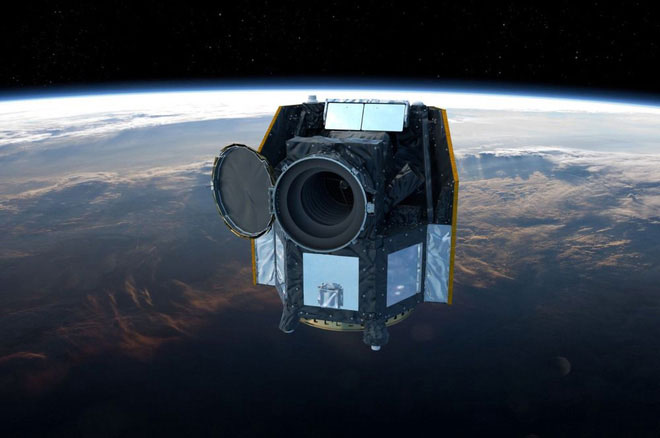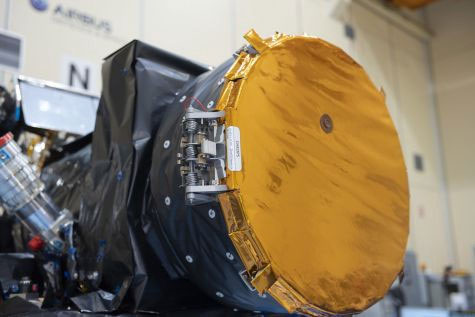This new satellite is designed to observe planets outside the Solar System
CHEOPS (CHaracterising ExOPlanets Satellite), launched from Guiana (France) on December 18, officially opened its electronic eyes to carry out the mission to monitor the sky.
CHEOPS is the result of a partnership between the European Space Agency (ESA) and the University of Bern. It was not designed to detect new worlds, but to carefully study the size, mass, and structure of known exoplanets. In the course of carrying out its mission, CHEOPS is able to combine learning of thousands of alien worlds with unprecedented levels of detail.

CHEOPS photo montage in space.
" Shortly after being launched on December 18, 2019, we tested satellite communication. Then, on January 8, 2020, we began commissioning - ie start up the computer, conduct tests, and launch all other components "- according to Willy Benz, professor of astrophysics at the University of Bern, and the chief investigator in the CHEOPS project.
During the launch and test run, the orbital observatory's lenses were protected by a 97cm coating, like the lens cover for a camera, to protect the lens from dust, foreign objects, and light from the sun.

CHEOPS lens cover.
Engineers at the Spanish National Institute of Aviation Technology (INTA) ordered the cover to be opened, preparing for the first data recording process from the satellite's camera.
An electronic signal is fired from a cylindrical tube made of alloy capable of reverting the shape, stretching the metal tube, breaking a screw inside. The process of this screw breaking caused the latch to latch loose, and thereby opened the "eyes" of CHEOPS.
" This open mechanism is famous for being extremely reliable, because it has been thoroughly tested while on the ground and has been used in previous space missions, but it was still a thrilling moment. , and we were all excited when the telescope opened its eyes to the universe, "said Francesco Ratti, engineer of the CHEOPS project.

CHEOPS is set to launch in December 2019.
CHEOPS is a small satellite belonging to the class S of ESA, with a length of 1.5m and a weight of 280kg.
The spacecraft in ESA class S program is quite small in size, and the price is not high (less than 55 million USD). The process of developing them is also quite fast. Because of such requirements, CHEOPS developers relied on the technologies and equipment available during the planning of new missions.
Since being launched on December 18, 2019 with the Soyuz Fregat rocket, CHEOPS has tested every task with a 100% success rate. It has entered the polar orbit (or orbiting the Earth from one pole to the other pole), 700km high just above the intersection of day and night.
Every system reported that the telescope was ready to go, and the program engineers ordered it to start observing the universe.
CHEOPS will study exoplanets previously discovered by other devices, focusing on how planets block infrared light from their stars during a complete round. trajectory. Each time a planet passes between its star and observatories on Earth, part of the light from that star is blocked. By measuring that intercept, astronomers can calculate the diameter and density of alien worlds - in short, measurement is at the heart of CHEOPS's mission.
Focusing on studying worlds larger than Earth but smaller than Neptune, CHEOPS will have to measure very small amounts of light blocked by the smallest exoplanets known.
The CHEOPS Observatory, from its observing position above the atmosphere, will provide us with information about exoplanets in unprecedented detail.
Together, TESS and the James Webb telescope can detect 10,000 planets orbiting other stars. Their findings will be utilized and deepened by CHEOPS, allowing astronomers to study worlds in unprecedented detail.
Over the next few months, the team will test CHEOPS with the first planets in other solar systems, and the first images from CHEOPS will be released in one to two weeks later.
CHEOPS is named after the pharaoh of Egypt 46 years ago, who ordered the construction of the Great Pyramid of Giza. The telescope in his name may be smaller than that giant tomb, but the desire it carries is far greater.
- Europe launches satellite search for extrasolar planets
- Europe will launch satellites to study planets
- Unknown mystery about planets outside the solar system
- Europe will launch satellites to study planets
- Europe launches satellite search for extrasolar planets
- Discover more than 700 planets outside the solar system
- Planets in the Solar System
- Unexpectedly the size of the largest Moon in the solar system
- The distance from the Earth to the celestial bodies in the solar system
- Why are there so many asteroids in the Solar System?
- Space Science: The order of 8 (or 9) planets in the Solar System
- NASA announces a map of 4,000 planets outside the Solar System
- Latest images of 7 planets in the Solar System version 2.0
- Not only the 9th planet, the solar system can own the 10th and 11th planets
 Van Allen's belt and evidence that the Apollo 11 mission to the Moon was myth
Van Allen's belt and evidence that the Apollo 11 mission to the Moon was myth The levels of civilization in the universe (Kardashev scale)
The levels of civilization in the universe (Kardashev scale) Today Mars, the sun and the Earth are aligned
Today Mars, the sun and the Earth are aligned The Amazon owner announced a secret plan to build a space base for thousands of people
The Amazon owner announced a secret plan to build a space base for thousands of people